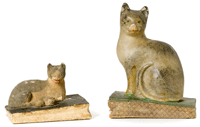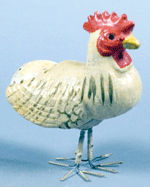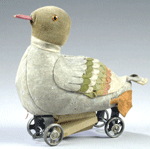|
Cowan's Corner
Tiny Toys Inspire Big Collectors
By Wes Cowan
There is nothing silent about a pip squeak auction. Although
some are more than 100 years old, pip squeaks have not lost that
spring in their step and are still highly sought after by collectors today.
The name is slightly misleading as pip squeak suggests that
something is diminutive or of little significance. While these highly
sought after collectibles are rather small, they are by no means
of little significance. The terminally charming and very folksy,
hand-painted pip squeak toy carries big weight with collectors of
folk art. The quality and charm of the animal subjects make pip
squeaks an affordable and highly collectable commodity, which
may not keep their squeaking noises, but will keep their charm and
value.
Believed to be European in origin, the pip squeak toy was
also made in the states, in particular in Pennsylvania during mid-
19th century. The “squeaks” are generally in the form of an animal,
composed of a paper pulp or some sort of chalky composite, and
attached to a paper or leather bellows. When pressed, the bellows
push air through a reed whistle inside that causes a squeak to be
associated with the critter.
The toys are usually some variety of bird and may have
spiral wire legs that make the body of the bird wiggle when the
bellows are pushed. Others have tiny wheels on the bellows,
which can either create the squeak or serve no apparent purpose.
Beginning collectors will buy any squeaks and be delighted
to have found them – as they don’t show up that often at
auction. Birds, mostly chickens, ducks, roosters and parrots,
with wire or stick legs, perched on a slanted bellows, are the
most pedestrian forms. You can often find them for $75 to $400.
Things to look for are intact bellows, good paint and
interesting forms. If a growing collection already has the requisite
squeak birds, look for quadrupeds—four-legged animals—like a
dog, cat or an elephant. Cats and cats with kittens are usually high
on a scale of “cute” and perform some small mechanical feat, such
as panting with a moveable tongue, as well as making a noise.
Collectors find squeaks that have moveable parts very
appealing. Unusual forms may fetch as much as $700-$800, still a
bargain for new collectors. These forms can include such things as
a rooster in a cage, an elephant or a squeak that performs another
function.
For more information: American Antique Toys – 1830-1900,
by Bernard Barenholtz and Inez McClintoch, Harry Abrams,
Inc., 1980, pp.118; or Toys A to Z: A Guide and Dictionary for
Collectors, Antique Dealers and Enthusiasts by Mark Rich, Krause
Publications, March 2001, pp 394.
 About the author: Wes Cowan is founder and owner of Cowan’s Auctions, Inc.
in Cincinnati, Ohio. An internationally recognized expert in
historic Americana, Wes stars in the PBS television series
History Detectives and is a featured appraiser on Antiques
Roadshow. He can be reached via email at info@cowans.com.
Article research by Diane Wachs. About the author: Wes Cowan is founder and owner of Cowan’s Auctions, Inc.
in Cincinnati, Ohio. An internationally recognized expert in
historic Americana, Wes stars in the PBS television series
History Detectives and is a featured appraiser on Antiques
Roadshow. He can be reached via email at info@cowans.com.
Article research by Diane Wachs.
|

Two cat pip squeaks, ca.1840-1900, one with
panting mechanism and a kitten; the other seated
on a plaid bellows.

Three hen pip squeaks, all 19th century. Two
are papier mâché examples with bellows, and the
third squeaks when the cage is closed.

Pip squeak
chicken
with
papier
mâché body

Felt-covered
pip squeak
duck,
mounted on
tin wheels
that when
rolled
activate
a squeak
bellow.
|